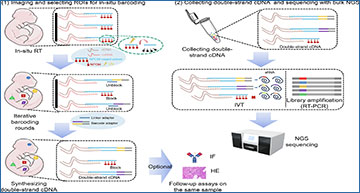
Understanding the complex details of how genes are expressed within different regions of a tissue is crucial for unraveling the complexities of biological systems and diseases. A new method developed by researchers at the Ocean University of China, called PBHL-seq (Photo-Irradiation for In-Situ Barcoding Hybridization and Ligation Sequencing), offers an exciting advancement in spatial transcriptomics, allowing scientists to profile gene expression with remarkable precision in intact tissue samples.
What is PBHL-seq?
PBHL-seq is a cutting-edge technique designed to analyze gene expression in specific regions of tissue samples. This method involves a process called photo-irradiation, where light is used to activate special molecules known as photo-caged oligodeoxynucleotides. These molecules are crucial for marking and identifying the exact location of gene expression within the tissue.
PBHL-seq overview
PBHL-seq enables selective barcoding of user-selected ROIs from frozen and FFPE tissue sections for transcriptome sequencing. Step (1): In situ RT with NPOM-caged primer is performed. Before photo irradiation, target ROIs can be selected based on phenotypic factors including spatial location, morphology, and protein biomarkers. The user selection allows large or small regions and contiguous or disjointed cell groups to be flexibly labeled by photo-irradiation and in-situ hybridization and ligation of DNA barcodes, which are then converted into sequenceable indices. The process can be re-iterated using different barcode sets for multiplexed targeting of different regions. Step (2): After photo-irradiation labeling, double-strand cDNAs are synthesized and released from the section, and sequencing libraries are prepared. Optionally, the same sample can be revisited after sequencing to perform follow-up assays, such as high-resolution imaging, morphology, or protein labeling. Different shapes: different ROIs. ROIs regions of interest, RT reverse transcription, IVT in vitro transcription, NPOM eight 6-nitropiperonyloxylmethyl, RT-PCR reverse transcription-polymerase chain reaction, NGS next-generation sequencing, IF immunofluorescence, HE hematoxylin-eosin staining.
Here’s how it works:
Photo-Irradiation: The tissue sample is exposed to light in specific regions, which activates the photo-caged molecules.
Reverse Transcription and Barcoding: Once activated, these molecules help convert RNA from the targeted regions into complementary DNA (cDNA). The cDNA is then labeled with unique barcodes that correspond to its location within the tissue.
Sequencing: The barcoded cDNA is sequenced to create detailed maps of gene expression across different regions.
What Makes PBHL-seq Special?
PBHL-seq offers several key advantages over traditional methods:
Spatial Precision: It allows for the targeted analysis of gene expression in specific areas of a tissue, even down to the subcellular level. This means scientists can pinpoint exactly where in the tissue different genes are active.
Versatility: The technique can be applied to a variety of tissue types, including those preserved in different ways, such as fresh frozen and formalin-fixed paraffin-embedded (FFPE) samples.
Large-Scale Analysis: PBHL-seq can analyze gene expression across large tissue areas, from microscopic regions to centimeter-scale sections, while keeping the sample intact for further studies.
Applications and Discoveries
Researchers have applied PBHL-seq to various samples, including mouse embryos and brain tissues. This method has revealed thousands of differentially expressed genes across different regions, providing valuable insights into tissue development and function. Additionally, PBHL-seq has been used to study gene expression within specific subcellular structures, such as the cytoplasm and nucleus, uncovering detailed information about cellular processes.
Why This Matters
The ability to profile gene expression with such precision is a game-changer for many fields of research. It enhances our understanding of how genes are regulated in different parts of a tissue and how these patterns relate to normal development and disease. For example, this method could improve our knowledge of how tumors develop or how brain regions function, leading to better diagnostic and therapeutic strategies.
PBHL-seq represents a significant leap forward in spatial transcriptomics. By enabling detailed and localized analysis of gene expression in intact tissue samples, it provides researchers with powerful new tools to explore the complexities of biological systems and advance our understanding of health and disease.
